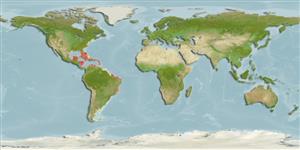>
Ovalentaria/misc (Various families in series Ovalentaria) >
Pomacentridae (Damselfishes) > Microspathodontinae
Etymology: Stegastes: Greek, stegastos, -e, -on = covered (Ref. 45335); fuscus: Named for its type locality, Trindade I..
More on author: Cuvier.
Environment: milieu / climate zone / depth range / distribution range
Ecologie
marien rifbewoner; standvastig; diepte 1 - 15 m (Ref. 40395), usually 1 - 4 m (Ref. 9626). Tropical
Western Atlantic: Brazil. Some authors consider the population in Caribbean Sea as another species, Pomacentrus dorsopunicans (Ref. 9626). Reported in the eastern Atlantic off Senegal (Ref. 10797).
Lengte bij maturiteit / Grootte / Gewicht / Leeftijd
Maturity: Lm 7.0 range ? - ? cm
Max length : 12.6 cm TL mannelijk / geslacht onbekend; (Ref. 9626)
Dorsale stekels (totaal): 12; Dorsale zachte stralen (totaal): 15-16; Anale stekels 2; Anale zachte stralen: 13 - 14
Adults inhabit shallow, coral or rocky bottoms and sometimes near the shore in areas with little visibility (Ref. 9626). Juveniles were collected from tide pools and on rocky Lithothamnion reefs; adults found up to 15 m depth (Ref. 40395). A diurnal species, adults feed on benthic algae, polychaetes and harpacticoid copepods (Ref. 9626); also consume hydroids and sponges and has been observed to feed on Abudefduf saxatilis eggs at night (Ref. 9626). 16:21 SL/TL (Ref. 9626). Oviparous, distinct pairing during breeding; eggs are demersal and adhere to the substrate; males guard and aerate the eggs (Ref. 205).
Levenscyclus en paargedrag
Maturiteit | Voortplanting | Paaien | Eieren | Fecunditeit | Larven
Oviparous, distinct pairing during breeding (Ref. 205). Eggs are demersal and adhere to the substrate (Ref. 205). Males guard and aerate the eggs (Ref. 205).
Allen, G.R., 1991. Damselfishes of the world. Mergus Publishers, Melle, Germany. 271 p. (Ref. 7247)
Status op de Rode Lijst van het IUCN (Ref. 130435)
Gevaar voor de mens
Harmless
Gebruik door de mens
Meer informatie
ReferentiesAquacultuurAquacultuurprofielKweeklijnenGeneticaElectrophoresesErfelijkheidZiektesVerwerkingNutrientsMassaconversie
Tools
Speciale rapporten
Download XML
Internetbronnen
Estimates based on models
Preferred temperature (Ref.
123201): 23.6 - 28.1, mean 27.3 °C (based on 775 cells).
Fylogenetische diversiteitsindex (Ref.
82804): PD
50 = 0.5000 [Uniqueness, from 0.5 = low to 2.0 = high].
Bayesian length-weight: a=0.01514 (0.00861 - 0.02661), b=3.03 (2.87 - 3.19), in cm total length, based on LWR estimates for this species & (Sub)family-body (Ref.
93245).
Trofisch niveau (Ref.
69278): 3.3 ±0.23 se; based on food items.
Generation time: 5.8 ( na - na) years. Estimated as median ln(3)/K based on 1
growth studies.
Weerstandsvermogen (Ref.
120179): Gemiddeld, minimale populatieverdubbelingstijd 1,4-4,4 jaar (Preliminary K or Fecundity.).
Fishing Vulnerability (Ref.
59153): Moderate vulnerability (37 of 100).
Nutrients (Ref.
124155): Calcium = 82.9 [43.6, 138.3] mg/100g; Iron = 0.621 [0.369, 1.032] mg/100g; Protein = 18.7 [17.5, 19.7] %; Omega3 = 0.137 [0.083, 0.226] g/100g; Selenium = 17.8 [9.1, 34.0] μg/100g; VitaminA = 222 [66, 717] μg/100g; Zinc = 1.92 [1.30, 2.68] mg/100g (wet weight);
